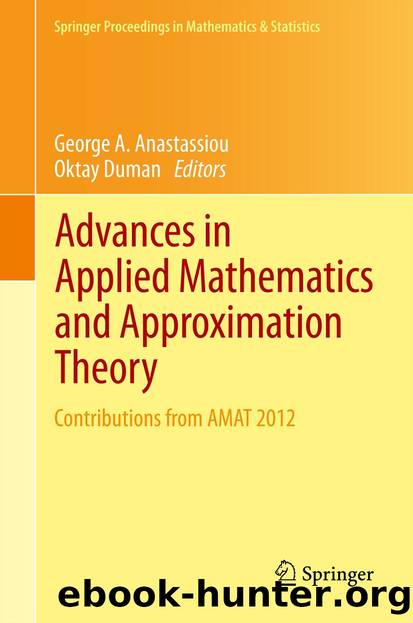Advances in Applied Mathematics and Approximation Theory by George A. Anastassiou & Oktay Duman

Author:George A. Anastassiou & Oktay Duman
Language: eng
Format: epub
Publisher: Springer New York, New York, NY
15.1 Introduction
The Stokes equation plays a fundamental role in the modeling of several problems in emerging geodynamics applications. Numerical solutions to the Stokes flow problems especially with high-contrast variations in viscosity are critically needed in the computational geodynamics community; see recent studies [27, 28, 33, 43]. The high-contrast viscosity corresponds to a small Reynolds number regime because the Reynolds number is inversely proportional to the viscosity value. One of the main applications of the high-contrast Stokes equation is the study of earth’s mantle dynamics. The processes such as the long timescale dynamics of the earth’s convecting mantle and the formation and subsequent evolution of plate tectonics can be satisfactorily modeled by the Stokes equation; see [28, 33, 34] for further details. Realistic simulation of mantle convection critically relies on the treatment of the two essential components of simulation: the contrast size in viscosity and the mesh resolution. Hence, our aim is to achieve robustness of the underlying preconditioner with respect to the contrast size and the mesh size simultaneously, which we call as m- and h-robustness, respectively.
Roughness of PDE coefficients causes loss of robustness of preconditioners. In [3, 4] Aksoylu and Beyer have studied the diffusion equation with such coefficients in the operator theory framework and have showed that the roughness of coefficients creates serious complications. For instance, in [4], they have shown that the standard elliptic regularity in the smooth coefficient case fails to hold. Moreover, the domain of the diffusion operator heavily depends on the regularity of the coefficients. Similar complications also arise in the Stokes case. This article came about from a need to address solver complications through the help of robust preconditioning. For that, we construct a robust preconditioner based on the one proposed in [2], which we call as the Aksoylu–Graham–Klie–Scheichl (AGKS) preconditioner. The AGKS preconditioner originates from the family of robust preconditioners constructed in [5]. It was proven and numerically verified to be m- and h-robust simultaneously.
The AGKS preconditioner was originally designed for the high-contrast diffusion equation under finite element discretization. In [6] we extended the AGKS preconditioner from finite element discretization to cell-centered finite volume discretization. Hence, we have shown that the same preconditioner could be used for different discretizations with minimal modification. Furthermore, in [7], we applied the same family of preconditioners to high-contrast biharmonic plate equation. Therefore, we have accomplished a desirable preconditioning design goal by using the same family of preconditioners to solve the elliptic family of PDEs with varying discretizations. In this article, we aim to bring the same preconditioning technology to vector -valued problems such as the Stokes equation. We extend the usage of AGKS preconditioner to the solution of the stationary Stokes equation in a domain Ω ⊂ ℝ 2:
Download
This site does not store any files on its server. We only index and link to content provided by other sites. Please contact the content providers to delete copyright contents if any and email us, we'll remove relevant links or contents immediately.
Algorithms of the Intelligent Web by Haralambos Marmanis;Dmitry Babenko(7852)
Hadoop in Practice by Alex Holmes(5660)
Jquery UI in Action : Master the concepts Of Jquery UI: A Step By Step Approach by ANMOL GOYAL(5512)
Life 3.0: Being Human in the Age of Artificial Intelligence by Tegmark Max(4507)
Functional Programming in JavaScript by Mantyla Dan(3723)
The Age of Surveillance Capitalism by Shoshana Zuboff(3422)
Big Data Analysis with Python by Ivan Marin(3009)
Blockchain Basics by Daniel Drescher(2891)
The Rosie Effect by Graeme Simsion(2708)
WordPress Plugin Development Cookbook by Yannick Lefebvre(2602)
Hands-On Machine Learning for Algorithmic Trading by Stefan Jansen(2518)
Applied Predictive Modeling by Max Kuhn & Kjell Johnson(2478)
Dawn of the New Everything by Jaron Lanier(2438)
Test-Driven Development with Java by Alan Mellor(2380)
The Art Of Deception by Kevin Mitnick(2297)
Data Augmentation with Python by Duc Haba(2225)
Rapid Viz: A New Method for the Rapid Visualization of Ideas by Kurt Hanks & Larry Belliston(2195)
Human Dynamics Research in Smart and Connected Communities by Shih-Lung Shaw & Daniel Sui(2178)
The Infinite Retina by Robert Scoble Irena Cronin(2176)
